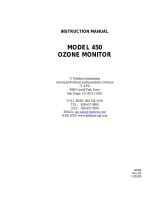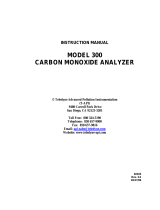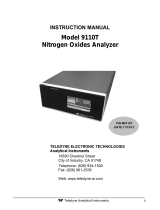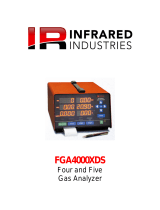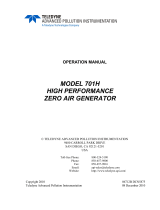Page is loading ...

User Manual
Model N500
CAPS NO
X
Analyzer
with NumaView™ software
© TELEDYNE API (TAPI)
9970 CARROLL CANYON ROAD
SAN DIEGO, CALIFORNIA 92131-1106
USA
Toll-free Phone:
+1 800-324-5190
Phone:
+1 858-657-9800
Fax:
+1 858-657-9816
Email:
api-sales@teledyne.com
Website:
http://www.teledyne-api.com/
Copyright 2020 08977B DCN8302
Teledyne API 12 June 2020


08977B DCN8302 Teledyne API N500 CAPS NO
X
Analyzer with NumaView™ Software i
NOTICE OF COPYRIGHT
© 2020 Teledyne API (TAPI). All rights reserved.
TRADEMARKS
All trademarks, registered trademarks, brand names or product names appearing in
this document are the property of their respective owners and are used herein for
identification purposes only.

ii Teledyne API N500 CAPS NO
X
Analyzer with NumaView™ Software 08977B DCN8302
SAFETY MESSAGES
Important safety messages are provided throughout this manual for the purpose of
avoiding personal injury or instrument damage. Please read these messages
carefully. Each safety message is associated with a safety alert symbol and is placed
throughout this manual; the safety symbols are also located inside the instrument. It
is imperative that you pay close attention to these messages, the descriptions of
which are as follows:
WARNING: Electrical Shock Hazard
HAZARD: Strong oxidizer
GENERAL WARNING/CAUTION: Read the accompanying message
for specific information.
CAUTION: Hot Surface Warning
Do Not Touch: Touching some parts of the instrument without
protection or proper tools could result in damage to the part(s)
and/or the instrument.
Technician Symbol: All operations marked with this symbol are to be
performed by qualified maintenance personnel only.
Electrical Ground: This symbol inside the instrument marks the
central safety grounding point for the instrument.
CAUTION
This instrument should only be used for the purpose and in the
manner described in this manual. If you use this instrument in a
manner other than that for which it was intended, unpredictable
behavior could ensue with possible hazardous consequences.
NEVER use any combustible/explosive gas with this instrument!
For Technical Assistance regarding the use and maintenance of this instrument or
any other Teledyne API product, contact Teledyne API’s Technical Support
Department:
Telephone: +1 800-324-5190
Email: api-techsupport@teledyne.com
or access any of the service options on our website at http://www.teledyne-api.com/

08977B DCN8302 Teledyne API N500 CAPS NO
X
Analyzer with NumaView™ Software iii
CONSIGNES DE SÉCURITÉ
Des consignes de sécurité importantes sont fournies tout au long du présent manuel
dans le but d’éviter des blessures corporelles ou d’endommager les instruments.
Veuillez lire attentivement ces consignes. Chaque consigne de sécurité est
représentée par un pictogramme d’alerte de sécurité; ces pictogrammes se retrouvent
dans ce manuel et à l’intérieur des instruments. Les symboles correspondent aux
consignes suivantes :
AVERTISSEMENT : Risque de choc électrique
DANGER : Oxydant puissant
AVERTISSEMENT GÉNÉRAL / MISE EN GARDE : Lire la
consigne complémentaire pour des renseignements
spécifiques
MISE EN GARDE : Surface chaude
Ne pas toucher : Toucher à certaines parties de l’instrument
sans protection ou sans les outils appropriés pourrait entraîner
des dommages aux pièces ou à l’instrument.
Pictogramme « technicien » : Toutes les opérations portant ce
symbole doivent être effectuées uniquement par du personnel
de maintenance qualifié.
Mise à la terre : Ce symbole à l’intérieur de l’instrument
détermine le point central de la mise à la terre sécuritaire de
l’instrument.
MISE EN GARDE
Cet instrument doit être utilisé aux fins décrites et de la
manière décrite dans ce manuel. Si vous utilisez cet instrument
d’une autre manière que celle pour laquelle il a été prévu,
l’instrument pourrait se comporter de façon imprévisible et
entraîner des conséquences dangereuses.
NE JAMAIS utiliser de gaz explosive ou combustible avec cet
instrument!

iv Teledyne API N500 CAPS NO
X
Analyzer with NumaView™ Software 08977B DCN8302
WARRANTY
WARRANTY POLICY (02024J)
Teledyne API (TAPI), a business unit of Teledyne Instruments, Inc., provides that:
Prior to shipment, TAPI equipment is thoroughly inspected and tested. Should
equipment failure occur, TAPI assures its customers that prompt service and support
will be available. (For the instrument-specific warranty period, please refer to the
“Limited Warranty” section in the Terms and Conditions of Sale on our website at
the following link: http://www.teledyne-api.com/terms_and_conditions.asp).
COVERAGE
After the warranty period and throughout the equipment lifetime, TAPI stands ready
to provide on-site or in-plant service at reasonable rates similar to those of other
manufacturers in the industry. All maintenance and the first level of field
troubleshooting are to be performed by the customer.
NON-TAPI MANUFACTURED EQUIPMENT
Equipment provided but not manufactured by TAPI is warranted and will be
repaired to the extent and according to the current terms and conditions of the
respective equipment manufacturer’s warranty.
PRODUCT RETURN
All units or components returned to Teledyne API should be properly packed for
handling and returned freight prepaid to the nearest designated Service Center. After
the repair, the equipment will be returned, freight prepaid.
The complete Terms and Conditions of Sale can be reviewed at
http://www.teledyne-api.com/terms_and_conditions.asp
CAUTION – Avoid Warranty Invalidation
Failure to comply with proper anti
-Electro-Static Discharge (ESD)
handling and packing instructions and Return Merchandise
Authorization (RMA) procedures when returning parts for repair or
calibration may void your warranty. For anti
-ESD handling and
packi
ng instructions please refer to the manual, Fundamentals of
ESD, PN 04786, in its
“Packing Components for Return to Teledyne
API’s Customer Service”
section. The manual can be downloaded
from our website at
http://www.teledyne-api.com. RMA procedures
can
also be found on our website.

08977B DCN8302 Teledyne API N500 CAPS NO
X
Analyzer with NumaView™ Software v
ABOUT THIS MANUAL
Note
We recommend that all users read this manual in its entirety
before operating the instrument.
CONVENTIONS USED
In addition to the safety symbols as presented in the Safety Messages page, this
manual provides special notices related to the careful and effective use of the
instrument and related, pertinent information.
ATTENTION
COULD DAMAGE INSTRUMENT AND VOID WARRANTY
This special notice provides information to avoid damage
to your instrument and possibly invalidate the warranty.
Important
IMPACT ON READINGS OR DATA
Provides information about that which could either affect
accuracy of instrument readings or cause loss of data.
Note
Provides information pertinent to the proper care,
operation or maintenance of the instrument or its parts.

vi Teledyne API N500 CAPS NO
X
Analyzer with NumaView™ Software 08977B DCN8302
TABLE OF CONTENTS
Safety Messages ...................................................................................................................................... ii
Warranty .................................................................................................................................................. iv
Table of Contents .................................................................................................................................... vi
List of Figures .......................................................................................................................................... ix
List of Tables ............................................................................................................................................ x
1. INTRODUCTION, SPECIFICATIONS, APPROVALS, & COMPLIANCE ............................................... 11
Specifications .................................................................................................................................. 11
EPA Designation ............................................................................................................................. 12
Safety .............................................................................................................................................. 12
EMC ................................................................................................................................................ 12
2. GETTING STARTED .............................................................................................................................. 13
Unpacking ....................................................................................................................................... 13
Ventilation Clearance ........................................................................................................... 14
Instrument Layout ........................................................................................................................... 15
Front Panel ........................................................................................................................... 15
Rear Panel ........................................................................................................................... 16
Internal Chassis ................................................................................................................... 17
Connections and Startup ................................................................................................................. 18
Electrical Connections ......................................................................................................... 18
Connecting Power ................................................................................................. 18
Connecting Analog Outputs Option ....................................................................... 19
Connecting the Digital I/O Expansion Board Option ............................................. 20
Connecting Communications Interfaces ................................................................ 21
Pneumatic Connections ....................................................................................................... 22
Critical Tubing, Pressure, Venting and Exhaust Requirements ............................ 23
Basic Connections from Calibrator.......................................................................... 24
Pneumatic Flow Diagrams ................................................................................................... 25
Startup, Functional Checks and Calibration ........................................................................ 27
Startup ................................................................................................................... 27
Alerts: Warnings and Other Messages .................................................................. 28
Functional Checks ................................................................................................. 29
Calibration.............................................................................................................. 29
Menu Overview ............................................................................................................................... 30
Home Page .......................................................................................................................... 31
Dashboard ............................................................................................................................ 33
Alerts .................................................................................................................................... 34
Calibration ............................................................................................................................ 35
Utilities .................................................................................................................................. 36
Setup .................................................................................................................................... 36
Setup Menu: Features/Functions Configuration ............................................................................ 36
Setup>Data Logging (Data Acquisition System, DAS) ........................................................ 37
Configuring Trigger Types: Periodic ...................................................................... 39
Configuring Trigger Types: Conditional ................................................................ 40
Downloading DAS (Data Acquisition System) Data .............................................. 40
Setup>Events ....................................................................................................................... 41
Editing or Deleting Events ..................................................................................... 43
Using Events as Triggers for Data Logging ........................................................... 44
Setup>Dashboard ................................................................................................................ 44
Setup>AutoCal (with Valve Option) ..................................................................................... 44
Setup>Vars .......................................................................................................................... 45
Setup>Homescreen ............................................................................................................. 46
Setup>Digital Outputs (Option) ............................................................................................ 47

08977B DCN8302 Teledyne API N500 CAPS NO
X
Analyzer with NumaView™ Software vii
Setup>Analog Outputs (Option) ........................................................................................... 48
Manual Calibration of Voltage Range Analog Outputs Option .............................. 50
Manual Adjustment of Current Range Analog Outputs Option ............................. 50
Setup>Instrument ................................................................................................................. 52
Setup>Comm (Communications) ....................................................................................... 52
COM1 .................................................................................................................. 52
TCP Port1 ............................................................................................................ 53
TCP Port2 ............................................................................................................ 53
Network Settings ................................................................................................. 53
Transferring Configuration to Other Instruments ............................................................................ 55
3. COMMUNICATIONS AND REMOTE OPERATION ............................................................................... 56
Serial Communication ..................................................................................................................... 56
Ethernet ........................................................................................................................................... 56
NumaView™ Remote ...................................................................................................................... 56
4. CALIBRATION ........................................................................................................................................ 57
Important Precalibration Information ............................................................................................. 57
Calibration Requirements .................................................................................................... 57
Zero Air ................................................................................................................................ 58
Calibration (Span) Gas ........................................................................................................ 58
Span Gas for Multipoint Calibration ..................................................................................... 58
NO
2
Permeation Tubes ........................................................................................................ 59
Data Recording Devices ...................................................................................................... 59
Calibration Procedures .................................................................................................................... 60
Calibration and Check Procedures for Basic Configuration ................................................ 60
Zero Calibration Check and Actual Calibration ..................................................... 61
Span Calibration Check and Actual Calibration .................................................... 61
Calibration and Check Procedures with Valve Options Installed ......................................... 62
Use of Zero/Span Valve with Digital Expansion Board Option .............................. 62
Automatic Zero/Span Cal/Check (Auto Cal) ................................................................................... 63
Titration Efficiency (TE) Check/Calibration ..................................................................................... 65
EPA Protocol Calibration ................................................................................................................. 66
5. MAINTENANCE AND SERVICE ............................................................................................................ 67
Maintenance Schedule .................................................................................................................... 67
Predictive Diagnostics ..................................................................................................................... 68
Operational Health Checks ............................................................................................................. 69
Software/Firmware Updates ............................................................................................................ 70
Remote Updates .................................................................................................................. 70
Manual Reload/Update Procedures ..................................................................................... 70
Time Zone Changes ........................................................................................................................ 72
Hardware Maintenance Procedures ............................................................................................... 73
Replacing the Sample Filter ................................................................................................. 73
Replacing the AREF Scrubber and Filter Assembly ............................................................ 73
Replacing the Internal Pump ................................................................................................ 74
Changing the IZS Permeation Tube Option ......................................................................... 75
Checking for Pneumatic Leaks ............................................................................................ 76
Detailed Pressure Leak Check .............................................................................. 76
Performing a Sample Flow Check ......................................................................... 77
Service and Troubleshooting .......................................................................................................... 77
Fault Diagnosis with Alerts ................................................................................................... 78
Fault Diagnosis With Dashboard Functions ......................................................................... 79
Using the Diagnostic Signal I/O Functions .......................................................................... 79
Fault Diagnosis with LEDs ................................................................................................... 80
Calibration Problems ............................................................................................................ 83
Negative Concentrations ....................................................................................... 83
Absence of Analyzer Response to Sample Gas ................................................... 83

viii Teledyne API N500 CAPS NO
X
Analyzer with NumaView™ Software 08977B DCN8302
Unstable Zero and Span ........................................................................................ 83
Inability to Span - Deactivated SPAN Button ........................................................ 83
Inability to Zero - Deactivated ZERO Button ......................................................... 84
Non-Linear Response ............................................................................................ 84
Other Performance Problems .............................................................................................. 84
Excessive Noise .................................................................................................... 85
Slow Response ...................................................................................................... 85
AREF Warnings ..................................................................................................... 85
Subsystem Check for Troubleshooting ................................................................................ 86
AC Main Power ...................................................................................................... 86
LCD/Display Module .............................................................................................. 87
O
3
Generator Module............................................................................................. 87
O
3
Generator Override........................................................................................... 87
Internal Span Gas Generator and Valve Options .................................................. 87
RS-232 Communications ....................................................................................... 87
Service Procedures .............................................................................................................. 88
Fuse Replacement Procedure ............................................................................... 88
O
3
Generator Replacement ................................................................................... 89
Sample Conditioner Assembly Replacement ........................................................ 90
Frequently Asked Questions ........................................................................................................... 91
Technical Assistance ...................................................................................................................... 92
6. PRINCIPLES OF OPERATION .............................................................................................................. 93
Pneumatic Operation ...................................................................................................................... 95
Electronic Operation ........................................................................................................................ 96
Modules ................................................................................................................................ 96
Power Switches.................................................................................................................... 96
Glossary ................................................................................................................................................. 97

08977B DCN8302 Teledyne API N500 CAPS NO
X
Analyzer with NumaView™ Software ix
LIST OF FIGURES
Figure 2-1. Front Panel Layout ................................................................................................................... 15
Figure 2-2. Rear Panel Layout .................................................................................................................... 16
Figure 2-3. Internal Chassis Layout ............................................................................................................ 17
Figure 2-4. Analog Outputs Connectors Panel Option ............................................................................... 19
Figure 2-5. Digital I/O Connector Panel Option .......................................................................................... 20
Figure 2-6. Mainboard JP1 Location and Pin Arrangements ...................................................................... 21
Figure 2-7. Gas Line Connections from Calibrator – Basic Configuration .................................................. 24
Figure 2-8. Pneumatic Flow Diagram including Zero/Span Valve Option .................................................. 25
Figure 2-9. Pneumatic Flow Diagram including IZS Valve Option .............................................................. 26
Figure 2-10. Status Screens at Startup ....................................................................................................... 27
Figure 2-11. Home Page Example .............................................................................................................. 28
Figure 2-12. Viewing Active Alerts Page ..................................................................................................... 28
Figure 2-13. Sample Dashboard Page ....................................................................................................... 29
Figure 2-14. User Interface Orientation ...................................................................................................... 31
Figure 2-15. Concentration and Stability Graph (top) and Meter Graph (bottom) ...................................... 32
Figure 2-16. Dashboard Page ..................................................................................................................... 33
Figure 2-17. Active Alerts Page .................................................................................................................. 34
Figure 2-18. Active Alerts Cleared .............................................................................................................. 35
Figure 2-19. Utilities>Alerts Log of Active and Past Alerts and Events ...................................................... 35
Figure 2-20. Datalog Configuration, New Log Page ................................................................................... 37
Figure 2-21. Datalog Configuration, Existing Log ....................................................................................... 37
Figure 2-22. Creating a New Data Log ....................................................................................................... 38
Figure 2-23. Datalog Periodic Trigger Configuration .................................................................................. 39
Figure 2-24. Datalog - Conditional Trigger Configuration ........................................................................... 40
Figure 2-25. DAS Download Page .............................................................................................................. 40
Figure 2-26. Events List .............................................................................................................................. 41
Figure 2-27. Event Configuration ................................................................................................................ 42
Figure 2-28. Configured Event Sample ....................................................................................................... 43
Figure 2-29. Edit or Delete an Event ........................................................................................................... 43
Figure 2-30. Dashboard Display and Configuration .................................................................................... 44
Figure 2-31. Homescreen Configuration ..................................................................................................... 46
Figure 2-32. Digital Outputs Setup .............................................................................................................. 47
Figure 2-33. Analog Output Option Configuration Example ....................................................................... 48
Figure 2-34. Analog Outputs Group Calibration Screen ............................................................................. 49
Figure 2-35. Analog Outputs Option Manual Calibration Screen (AOUT2 Example) ................................. 49
Figure 2-36. Setup for Checking / Calibrating DCV Analog Output Signal Levels ..................................... 50
Figure 2-37. Setup for Checking / Calibrating Current Output Signal Levels ............................................. 51
Figure 2-38. Alternative Setup Using 250Ω Resistor for Checking Current Output Signal Levels ............. 51
Figure 2-39. Communications Configuration, Network Settings ................................................................. 54
Figure 2-40. Configuration Transfer ............................................................................................................ 55
Figure 4-1. Multi-Point Calibration Page ..................................................................................................... 61
Figure 4-2. Zero and Span Calibration Screens ......................................................................................... 62
Figure 4-3. Auto Cal Page........................................................................................................................... 63
Figure 5-1: Report Generation Page ........................................................................................................... 69
Figure 5-2. Remote Update Page ............................................................................................................... 70
Figure 5-3. Manual Update Page (and other utilities) ................................................................................. 70
Figure 5-4. Time Zone Change Requirements ........................................................................................... 72
Figure 5-5. Replacing the Sample Filter ..................................................................................................... 73
Figure 5-6. Pneumatic Layout of AREF Filter and Charcoal Filter.............................................................. 74
Figure 5-7. Internal Pump ........................................................................................................................... 75
Figure 5-8. N500 Mainboard ....................................................................................................................... 80
Figure 5-9. N500 CAPS DAQ Smart Board ................................................................................................ 81
Figure 5-10. N500 Ozone Tower Smart Board ........................................................................................... 82
Figure 5-11. Fuse Access ........................................................................................................................... 89

x Teledyne API N500 CAPS NO
X
Analyzer with NumaView™ Software 08977B DCN8302
Figure 6-1. N500 Optical Absorption Cell ................................................................................................... 94
Figure 6-2. Phase Shift Representation of Increased Concentration of NO
2
............................................. 94
LIST OF TABLES
Table 1-1. Specifications ............................................................................................................................. 11
Table 2-1. Ventilation Clearance ................................................................................................................. 14
Table 2-2. Rear Panel Description .............................................................................................................. 16
Table 2-3. Analog Output Pin Assignments ................................................................................................ 19
Table 2-4. Digital Input/Output Pin Assignments ........................................................................................ 20
Table 2-5. JP1 Configurations for Serial Communication ........................................................................... 21
Table 2-6. Menu Overview .......................................................................................................................... 30
Table 2-7. Utilities Submenu Descriptions .................................................................................................. 36
Table 2-8. List of Variables with Descriptions ............................................................................................. 45
Table 2-9. Analog Output Option Voltage/Current Range .......................................................................... 49
Table 2-10. Current Loop Output Check ..................................................................................................... 51
Table 2-11. Setup>Instrument Menu .......................................................................................................... 52
Table 2-12. COM1 Setup ............................................................................................................................ 52
Table 2-13. LAN/Ethernet Configuration Properties ................................................................................... 54
Table 3-1. Ethernet Status Indicators ......................................................................................................... 56
Table 4-1. AUTO CAL States ...................................................................................................................... 64
Table 4-2. Auto Cal Setup Combinations .................................................................................................... 64
Table 4-3. Auto Cal Programming Sequence Execution ............................................................................ 65
Table 5-1. Maintenance Schedule .............................................................................................................. 68
Table 5-2. Predictive Uses for Dashboard Functions ................................................................................. 69
Table 5-3. Warning Alerts, Fault Conditions and Possible Causes ............................................................ 78
Table 6-1. Sensor Signal Processing States .............................................................................................. 95
APPENDIX A – MODBUS REGISTERS
APPENDIX B – WIRING DIAGRAM

08977B DCN8302 Teledyne API 500 CAPS NO
X
Analyzer with NumaView™ Software 11
1. INTRODUCTION, SPECIFICATIONS, APPROVALS, &
COMPLIANCE
Teledyne API’s Model N500 CAPS NO
x
-NO
2
-NO Analyzer uses Cavity-Attenuated
Phase-Shift (CAPS) spectroscopy to render direct, true measurements of nitrogen dioxide
(NO
2
). By combining direct NO
2
measurements with highly efficient gas phase titration
(GPT), the N500 converts and measures the NO sample gas component as NO
2
, thus
allowing for the measurement of total NOx. Furthering its accuracy and dependability is
an auto-reference cycle to account and compensate for any potential baseline drift in the
measured loss, that may be caused by varying environmental conditions.
CAPS technology is superior to the traditional chemiluminescence method in both speed
and precision since the sampled NO
2
does not require catalytic conversion to calculate a
difference measurement.
Economically, the Model N500 CAPS NO
X
instrument is less costly to operate and
maintain than traditional analyzers in that it uses less power and fewer components.
The section on Principles of Operation provides more detail on the behavior and technique
of the CAPS method for NO
X
measurement.
SPECIFICATIONS
Table 1-1. Specifications
Parameter
Description
Ranges
Min: 0-5 ppb Max: 0-1 ppm NO
x
(full scale user-selectable)
Measurement Units
ppb, ppm, µg/m
3
, mg/m
3
(user-selectable)
Zero Noise
< 0.05 ppb (RMS)
Span Noise
< 0.2% of reading + 50 ppt (RMS)
Zero Drift
< 0.2 ppb / 24 hours
Span Drift
< 0.5% of reading / 24 hours
Lower Detectable Limit
< 0.1 ppb
Response Time
< 60 Seconds to 95%
Linearity
1% Full Scale
Precision
0.5% of reading above 5 ppb
Sample Flow Rate
1000 cc/min ±10%
AC Power
Rating
Typical Power Consumption
100 - 240 V~ 47-63 Hz 3.0 A
110 W
Power Entry Module Fuse
5.0 A, 250 V AC, 5 mm x 20 mm, SLO-BLO

12 Teledyne API N500 CAPS NO
X
Analyzer with NumaView™ Software 08977B DCN8302
Parameter
Description
Communications
Standard I/O
1 Ethernet: TCP/IP
1 RS-232 or RS-485 (user-configurable) (300 – 115,200 baud)
2 front panel USB device ports
Optional I/O
Universal Analog Output Board (all user-definable):
4 x isolated voltage outputs (5 V, 10 V)
3 x individually isolated current outputs (4-20 mA)
Digital I/O Expansion Board includes:
3 x isolated digital input controls (fixed)
5 x isolated digital output controls (user-definable)
3 x form C relay alarm outputs (user-definable)
Operating Temperature
0-40
o
C (with US EPA approval)
Humidity Range
0-95% RH, Non-Condensing
Dimensions HxWxD 7” x 17” x 23.5” (178 x 432 x 597 mm)
Weight 33 lbs (15 kg)
Environmental Conditions
• Installation Category (Over Voltage Category ) II Pollution
Degree 2
• Intended for Indoor Use Only at Altitudes ≤ 2000m
Note: All specifications are based on constant conditions
EPA DESIGNATION
Teledyne API’s Model N500 CAPS NOx analyzer is officially designated as US EPA
Automated Equivalent Method, Designation Number EQNA- 0320-256.
The official List of Designated Reference and Equivalent Methods is published in the
U.S. Federal Register,
http://www3.epa.gov/ttn/amtic/criteria.html, and specifies the
instrument’s settings and configurations.
SAFETY
IEC/EN 61010-1:2010 (3
rd
Edition), Safety requirements for electrical equipment for
measurement, control, and laboratory use.
CE: 2014/95/EU, Low-Voltage Directive
EMC
IEC/EN 61326-1, Class A Emissions/Industrial Immunity
FCC 47 CFR Part 15B, Class A Emissions
CE: 2014/108/EU, Electromagnetic Compatibility Directive

08977B DCN8302 Teledyne API N500 CAPS NO
X
Analyzer with NumaView™ Software 13
2. GETTING STARTED
This section addresses unpacking, connecting, and initializing the instrument, getting an
overview of the menu system, and setting up/configuring the functions.
UNPACKING
CAUTION - GENERAL SAFETY HAZARD
To avoid personal injury, always use two persons to lift and
carry the analyzer.
ATTENTION
COULD DAMAGE INSTRUMENT AND VOID WARRANTY
Printed Circuit Assemblies (PCAs) are sensitive to electro-static
discharges too small to be felt by the human nervous system. Failure
to use Electro-Static Discharge (ESD) protection when working with
electronic assemblies will void the instrument warranty. Refer to the
manual, Fundamentals of ESD, PN 04786, which can be downloaded
from our website at http://www.teledyne-api.com
.
ATTENTION
COULD DAMAGE INSTRUMENT AND VOID WARRANTY
Do not operate this instrument without first removing dust plugs from
SAMPLE and EXHAUST ports on the rear panel.
Note
Teledyne API recommends that you store shipping containers
and
materials for future use if/when the instrument should be
returned to the factory for repair and/or calibration service. See
Warranty statement in this manual and Return Merchandise
Authorization (RMA) on our Website at http://www.teledyne-
api.com.
Verify that there is no apparent external shipping damage. If damage has occurred, please
advise the shipper first, then Teledyne API.
Included with your instrument is a printed record of the final performance characterization
performed on your instrument at the factory. This record, titled Final Test and Validation
Data Sheet, is an important quality assurance and calibration record and should be placed
in the quality records file for this instrument.

14 Teledyne API N500 CAPS NO
X
Analyzer with NumaView™ Software 08977B DCN8302
With no power to the unit, carefully remove the top cover of the instrument and check for
internal shipping damage by carrying out the following steps:
1. Carefully remove the top cover and check for internal shipping damage.
a. Remove the screws located on the instrument’s sides.
b. Slide the cover backward until it clears the instrument’s front bezel.
c. Lift the cover straight up.
2. Inspect the interior of the instrument to ensure all circuit boards and other
components are intact and securely seated.
3. Check the connectors of the various internal wiring harnesses and
pneumatic hoses to ensure they are firmly and securely seated.
4. Verify that all of the optional hardware ordered with the unit has been
installed. These are listed on the paperwork accompanying the instrument.
WARNING – ELECTRICAL SHOCK HAZARD
Never disconnect PCAs, wiring harnesses or electronic
subassemblies while under power.
VENTILATION CLEARANCE
Whether the instrument is set up on a bench or installed in a rack, be sure to leave sufficient
ventilation clearance.
Table 2-1. Ventilation Clearance
AREA
MINIMUM REQUIRED CLEARANCE
Back of the instrument 10 cm / 4 in
Sides of the instrument
2.5 cm / 1 in
Above and below the instrument 2.5 cm / 1 in

08977B DCN8302 Teledyne API N500 CAPS NO
X
Analyzer with NumaView™ Software 15
INSTRUMENT LAYOUT
Instrument layout includes front panel, rear panel connectors, and the internal chassis layout.
FRONT PANEL
The front panel (Figure 2-1) includes two USB ports for peripheral device connections,
which can be used with mouse and keyboard as alternatives to the touchscreen interface,
or with flash drive for uploads/downloads (devices not included).
Figure 2-1. Front Panel Layout

16 Teledyne API N500 CAPS NO
X
Analyzer with NumaView™ Software 08977B DCN8302
REAR PANEL
Figure 2-2 shows the layout of the rear panel.
Figure 2-2. Rear Panel Layout
Table 2-2. Rear Panel Description
COMPONENT FUNCTION
Model/specs label
Identifies the analyzer model number and provides power specs.
SAMPLE
Connect a gas line from the source of sample gas here.
Calibration gases can also enter here on units without zero/span/shutoff valve options
installed.
EXHAUST
Connect an exhaust gas line of not more than 10 meters long here that leads outside the
shelter or immediate area surrounding the instrument. The line must be ¼” tubing or
greater.
SPAN
On units with zero/span valve option installed, connect a gas line to the source of
calibrated span gas here.
ZERO AIR
On units with zero/span valve option installed, attach a gas line to the source of zero air
here. If a permeation oven, also known as internal zero/span valve (IZS), option is
installed attach the zero air scrubber here.
Cooling fan
Pulls ambient air into chassis through side vents and exhausts through rear.
Power cable
connector
Connector for three-prong cord to apply AC power to the analyzer.
CAUTION! The cord’s power specifications (specs) MUST comply with the power
specs on the analyzer’s rear panel label
Power
On/Off
Switch
Rocker switch to power unit on or off.
CAUTION! Prior to powering OFF, use front panel button for preliminary internal “soft”
power-down to protect components from damage.
Fuse drawer
For circuit protection.
ANALOG OUT Option
For voltage or current loop outputs to a strip chart recorder and/or a data logger.
DIGITAL I/O Option
For remotely activating the zero and span calibration modes.
ETHERNET
Connector for network or Internet remote communication, using Ethernet cable.
COM
Serial communications port for RS-232 or RS-485.

18 Teledyne API N500 CAPS NO
X
Analyzer with NumaView™ Software 08977B DCN8302
CONNECTIONS AND STARTUP
This section presents the electrical (Section 2.3.1) and pneumatic (Section 2.3.2)
connections for setting up and preparing the instrument for operation (Section 2.3.3).
ELECTRICAL CONNECTIONS
Note
To maintain compliance with EMC standards, cable length
must be no greater than 3 meters for all I/O connections.
WARNING – Electrical Shock Hazard
• High Voltages are present inside the instrument’s case.
• Power connection must have functioning ground connection.
• Do not defeat the ground wire on power plug.
• Turn off instrument power before disconnecting or connecting
electrical subassemblies.
•
Do not operate with cover off.
CAUTION – Avoid Damage to the Instrument
Ensure that the AC power voltage matches the voltage indicated on
the instrument’s rear panel before plugging it into line power.
CONNECTING POWER
ATTENTION
COULD DAMAGE INSTRUMENT AND VOID WARRANTY
Never power off the instrument from the rear panel Hard
Power switch before first placing the internal
computerized components into deep sleep mode through
the front panel Soft Power switch. Press and momentarily
hold the front panel Soft Power switch, which triggers the
Supervisory chip to safely shut down the internal
components. The LED state then changes from solid lit to
blinking, at which time the rear panel Hard Power switch
can be used to power off the instrument.
Attach the power cord between the instrument’s AC power connector and a power outlet
capable of carrying at least the rated current at your AC voltage range and ensure that it is
equipped with a functioning earth ground. It is important to adhere to all safety and
cautionary messages.
/

